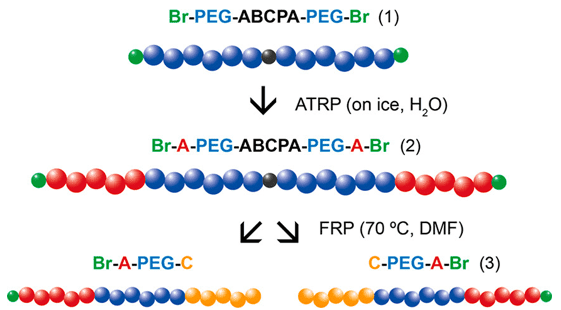Atom transfer radical polymerization (ATRP) is a living radical polymerization wherein the transition metal catalyst mediates a radical-generating, halogen-transfer reversible redox process. BOC Sciences provides our customers with the most competitive polymer products and thoughtful synthesis services worldwide. Our experienced R&D teams, advanced technology platforms, and trustworthy quality can resolve your research challenges.
Atom transfer radical polymerization (ATRP), also known as metal-mediated radical polymerization, is a powerful controlled radical polymerization technique that enables the precise synthesis of functional polymers with a determined molecular weight within narrow molecular weight distribution. Due to its applicability to various monomers, solvents, catalysts, and reaction conditions, ATRP has been employed to prepare a broad range of advanced polymeric materials with controlled architecture and functionality. Moreover, because it can be carried out in an aqueous solution at room temperature, ATRP is particularly useful for the conjugation of polymer chains to biological entities, such as proteins, peptides, nucleic acids, viruses, and even live cells.
 Fig. 1. Examples of polymers with a controlled composition prepared by ATRP (Macromolecules. 2017, 50(21): 8390-8397).
Fig. 1. Examples of polymers with a controlled composition prepared by ATRP (Macromolecules. 2017, 50(21): 8390-8397).
Matyjaszewski and Sawamoto first reported the concept of atom transfer radical polymerization (ATRP) in 1995. In this technique, molecular weight is predetermined by the ratio between monomer and initiator. Radicals are generated through a halogen-transfer process mediated by a metal catalyst, usually containing copper or ruthenium. The halogen is transferred from initiators to transition metals with increased oxidation states, and reverse reactions can then cap radicals. This activation-deactivation process provides control: when the deactivation rate is higher than activation rate, a low concentration of radicals is present and results in a low occurrence of termination events as well as constant growth of polymer chains. As a result, ATRP has been employed in polymerizing a wide range of monomers, including styrenes, alkyl(meth)acrylates, acrylonitrile, and (meth)acrylamides.

The five most important variables involved with atom transfer radical polymerization (ATRP) are monomer, initiator, catalyst, ligand, and solvent. ATPR realized a controllable increase in molecular weight, molecular architecture, and polymer composition while maintaining a low polydispersity (1.05-1.2). BOC Sciences' R&D team is able to synthesize polymers through ATRP efficiently by putting together monomers in a controlled piece-by-piece fashion. Moreover, assembling polymers in such a manner has allowed our scientists to create a wide range of polymers with site-specific tailored functionalities targeting specific properties for high-value applications. However, with the rapid expansion of different monomers and biomolecules, ATRP remained a versatile tool to prepare polymer bioconjugates has also greatly evolved, especially under biologically relevant conditions. Based on this, we also offer the following new ATRP synthesis techniques, including activators regenerated by electron transfer (ARGET) ATRP, initiators for continuous activator regeneration (ICAR) ATRP, electrochemically mediated ATRP (eATRP), and photoinitiated ATRP (photo-ATRP), which allow the preparation of polymer conjugates with low catalyst loading under biologically benign polymerization conditions.

References